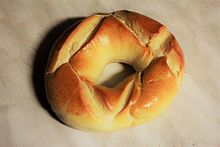Agatha bread
Agathabrot or Agathenbrot (also in Swiss : Agatha-Brötli ) is blessed and distributed in many Catholic areas of the Alps on February 5th, the commemoration day of St. Agatha of Catania , or the evening before it.
history
Agatha was bread as protection against fever and diseases of the breast considered and should against homesickness help the yes often "like fire burning." This bread, which symbolizes the breasts cut off during the martyrdom of the saints , was given to women immediately after the birth of a child in order to ensure the flow of milk. It was fed to the cattle before the cattle drive up to the alpine pastures so that the cows should get along, oxen before the first harness before a plow and cows before calving. A piece was deposited in the stables and was used as a means of protection and medicine for the cattle. The farmers took the agatha bread with them to the alp in order to place it next to the cross in the huts as protection for the cattle. Even before the grazing land, the animals were fed a piece of food to keep the animals away from harm. Scattered crumbs of this bread in corners protect from fire. Sometimes the five fingers of the right hand were pressed into the first loaf of bread that came into the oven while baking bread and a blessing was said. When a fire broke out in the place, this handle loaf was thrown into the fire.
Agatha bread, in which a cross is cut, or agatha buns, usually shaped like small breasts, were brought to church for blessing . Sometimes the pastor comes to the bakery early in the morning and blesses the freshly baked bread. Sometimes the loaves of bread are provided with an agatha label , also in the form of a decorated paper heart. In Switzerland, agatha bread is mostly pretzel-shaped , and there is also agatharingli, a ring- shaped white bread that is made from blessed flour.
Many peasant customs are associated with agatha bread: a piece of agatha bread should always be kept in the house, which supposedly could not get moldy. This ensured that there was always enough bread for the family. Agatha bread was given to the sick and servants who took up a new position.
On the Kristberg north of Silbertal in Vorarlberg , a church dedicated to St. Agatha was built at the beginning of the 16th century, according to tradition as the redemption of the vow to rescue buried miners from the collapsed tunnel of the silver mine at this point. To this day, Agathen bread is blessed in a festive service on Remembrance Day .
In the parish church of Agathazell near Immenstadt , which is consecrated to the saint, several baskets of white bread are consecrated according to old custom on the day of the saint's remembrance and distributed to the poor of the city.
Saint Agatha is the patron saint of the fire brigade . According to tradition, a lava flow on Mount Etna was brought to a standstill with the help of the relic of the veil of St. Agatha. Such stories are also circulating in Zug. A fire in Zeughausgasse is said to have been put out only after the fire-fighting force threw two blessed agatha rolls into the fire.
literature
- Ueli Kleeb: The year of Switzerland in celebration and custom. Artemis, Zurich 1981.
- Schweizerisches Idiotikon , Volume V, Huber, Frauenfeld 1901–1905, Column 953 f., Article Agathe n brōt ( digitized version ).
Web links
- Ecumenical Lexicon of Saints
- From Petra's bakery
- Agatha bread in the database of Swiss culinary heritage

